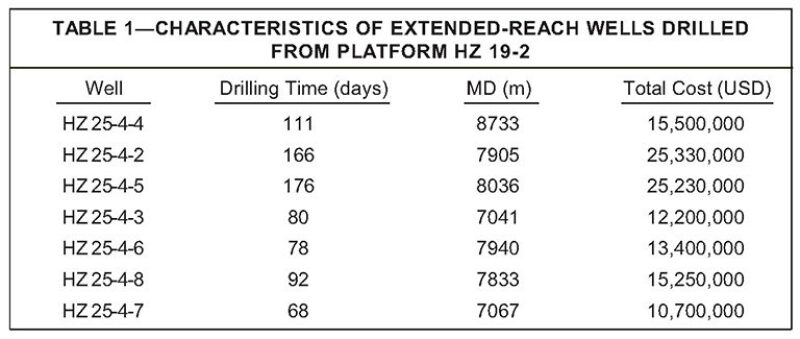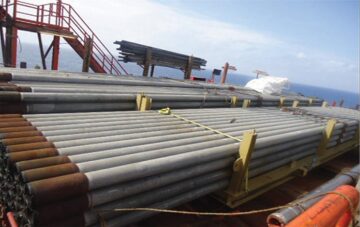This paper presents the results of a performance-improvement effort in extended-reach drilling (ERD) in three campaigns in the Huizhou HZ 25-4 oil field in the South China Sea. The new methodological approach and the deployment of new-generation aluminum drillpipes (ADPs) have resulted in a reduction of drilling risk and increased cost savings.
Introduction
ERD allows the reduction of the number of drilling sites, including offshore platforms, artificial islands, or other structures, and allows better control of total field-development costs. In addition, ERD technology makes it possible to reach reservoirs located at a considerable distance offshore, reducing the environmental impact of a wellsite. ERD operations are gaining momentum in the industry because they allow reserves exploitation previously considered too expensive when using conventional drilling methods. In addition, ERD techniques increase single-well production by enlarging the drainage area. Because of their lighter weight when compared with steel drillpipes (SDPs), the use of ADP is a key solution for drilling extended--reach wells for the following reasons:
- A reduction in operating costs of approximately 10–20% (including savings in rig-capacity upgrade costs, transportation and energy costs, time-hosting costs, and tool-joint/casing-wear costs).
- An increase in the horizontal deviation of wells of approximately 10–30% (reduced torque-and-drag effect, less pressure drop, higher buckling resistance).
- Heightened reserves and production growth.
- A reduction in operative risk.
Comparison of ADPs and SDPs
Eni E&P first considered ADPs in July 2003, during the proposal and approval of a research-and-development project.
During the execution of the project (July 2003 to June 2006), the following activities were performed:
- Verification of ADP design by means of laboratory tests at Pisa University.
- Manufacturing of 4000 m of ADP by a Russian company.
- Two field tests of ADP with ceramic centralizers/protectors (this first generation of ADPs was called ADP 1) in Monte Enoc Well 10H in the Val d’Agri field (Italy) in May 2005 and in the Villano 14H well in the Villano A field (Ecuador) in January 2006. These two field tests confirmed the following advantages of ADPs in comparison with SDPs:
- Less weight (the specific gravity of aluminum is approximately one-third that of steel), with a consequent ease of handling and transport and the potential for greater measured depth (MD) drilling with the same rig capacity
- Increased flexibility
- Good yield strength
- High resistance to temperature
- Lower torque and drag
- Less casing wear
- Better hydraulics (fewer pressure drops)
- Strong fatigue resistance
- Strong corrosion resistance
- Less energy consumption
- Constraints of ADPs in comparison with the SDPs are
- Reduced Brinell-scale hardness
- A need for dedicated handling equipment
- pH limitation (corrosion rate increases when pH is greater than 10.5)
- Greater external-surface wear caused by ADP contact with borehole (in particular for high rotation velocity and in deviated wells)
As a conclusion of this first project, ADP was seen to be particularly suitable for the application in extended-reach wells, but it was necessary to solve the problem of high external-surface wear in the middle sections of pipes.
Therefore, in June 2008, a second project was initiated; the goal was to improve the external protection of the ADPs to increase their reliability.
In mid-2011, we prepared a second generation of ADPs (called ADP 2), manufactured by the same Russian company, with a threaded coupling in steel in the middle of the pipe to reduce the external surface wear observed in ADP 1. This second generation of ADPs (2000 m) was tested with success (in both cased and openhole drilling) in May and June of 2012 in the Huizhou HZ 25-4 field in the South China Sea for drilling extended-reach Well HZ 25-4-7 from Platform HZ 19-2. This is a long S-shaped well of 7067-m MD and 2341-m true vertical depth (TVD), with a tangent angle of 84° and a drop angle at 39°, with a total displacement of 5500 m.
ADP Technology for ERD in the Huizhou Field
The Huizhou HZ 25-4 field was discovered in December of 2005 by a vertical exploratory well drilled by a semisubmersible rig. The field is characterized by multiple oil-bearing zones and is located in Block 16/19 of the Pearl River basin, located 6 km southwest of the HZ 19-2 platform in a water depth of 102 m. After discovery, extensive studies were conducted for the development of this field. It was decided to upgrade the existing drilling-rig unit on the nearby HZ 19-2 platform and to drill extended-reach wells from the HZ 19-2 platform.
Seven wells have been drilled so far from the HZ 19-2 platform in three different drilling campaigns. Fig. 1 shows a basic representation of the proposed well pattern for the five directional HZ 25-4 extended-reach wells from the platform. Note that the directional trajectories are built and held with ±85° tangent angles that are then azimuthally turned approximately 120° to the left to intersect the target sections, which are trapped by a large field fault. This is to allow up to 550 m of lateral horizontal drilling of the production hole parallel to the fault to optimally drain the reserves.

The actual well designs for the HZ 25-4 campaign are 26-in. hole with 20‑in. conductor casing, followed by 16‑in. directional hole with 13⅜-in. surface casing, followed by a 12¼-in. hole with 9⅝-in. intermediate casing, followed by an 8½-in. hole with a 7-in. liner. The lateral production holes are drilled with a 6-in. bit and are typically completed with 4-in. standalone screens in the open hole. The wells are completed with 4½-in. tubing by use of electrical-submersible--pump systems.
The drilling time, the MD, and the total cost of the seven extended-reach wells drilled in the field from the platform are shown in Table 2. Well HZ 25‑4-7, drilled with ADP 2, features cost savings of approximately 18% and time savings of approximately 15% in comparison with Wells HZ 25-4-3 and HZ 25-4-6, drilled with ADP 1. Well HZ 25-4-7 also shows cost savings of approximately 57% and time savings of approximately 60% in comparison with Wells HZ 25-4-2 and HZ 25-4-5, drilled with extreme difficulty using conventional technology.

The main challenge of this well was the minimum TVD vs. displacement at the 9⅝-in.-casing shoe. This made drilling difficult, and it was also necessary to manage wellbore-stability issues and high predicted torque caused by the shape of the well, with a dropping angle of 39°. Ultimately, a significant time savings was achieved, caused by the smooth trip out of the well in the 12¼-in. section and a 10-day reduction in back-reaming time compared with previously drilled wells. This gain in time can be credited to (a) the deployment of 2000 m of ADP 2 (Fig. 2), (b) an optimized new approach for drilling management in both design and execution, and (c) more-consolidated drilling procedures.

ADP 2 has been designed to work in open holes as well, thanks to the steel tool joints and a connector positioned in the center of the pipe for protection from the wear and tear during drilling. The large diameter of the pipe (5⅞ in.) also allowed for better hydraulics and a higher pipe/hole-area ratio, resulting in better hole-cleaning action and dramatically reducing the time needed to pull the drilling bottomhole assembly out of the hole and the time of the wiper trip, allowing a very smooth casing run.
The 8½-in. drilling phase also benefited from ADP because there was considerable reduction of the surface torque and hookload. The ADPs also have a lower friction factor when compared with SDPs in open and cased hole while dramatically reducing the torque and side force, allowing better protection against casing wear. Other benefits of ADP 2 include better hydraulic parameters, which allow better hole cleaning and reduce the risk of packoff.
This article, written by JPT Technology Editor Chris Carpenter, contains highlights of paper IPTC 16798, “New Generation of Aluminum Drillpipes Enhanced ERD Performances in the Huizhou Field, South China Sea,” by W. Scaruffi, E. Cristofanelli, S. Yu, and A. Trocchia, Eni China, and C. Molaschi and A. Merlo, Eni, prepared for the 2013 International Petroleum Technology Conference, Beijing, 26–28 March. The paper has not been peer reviewed. Copyright 2013 International Petroleum Technology Conference. Reproduced by permission.

